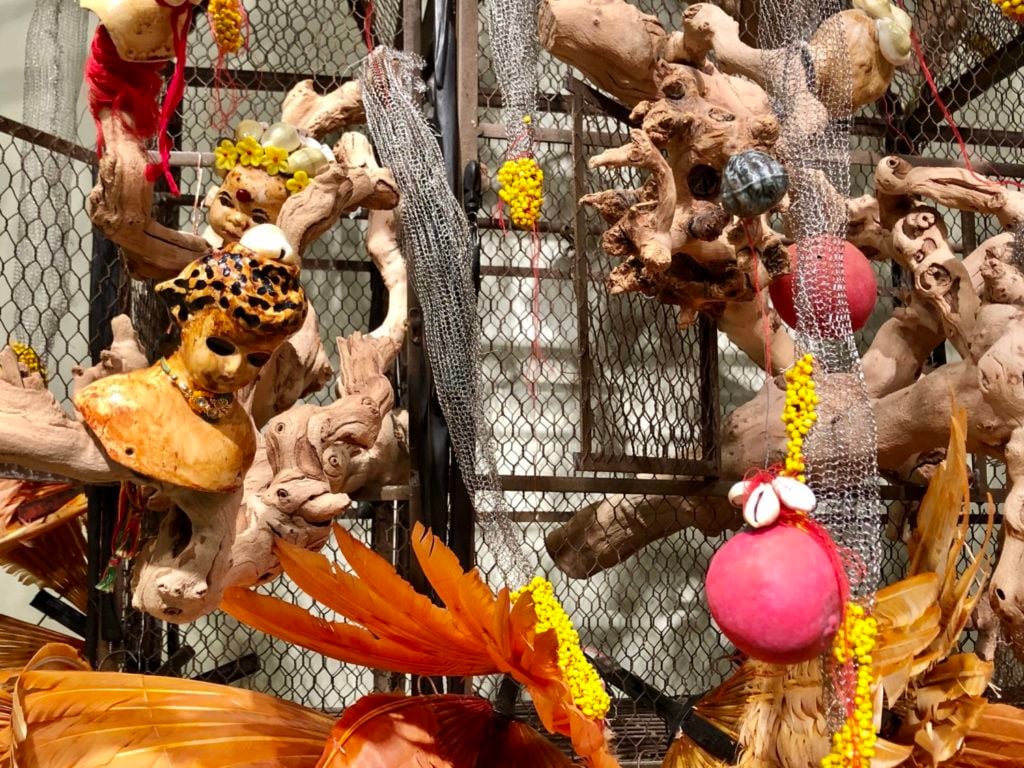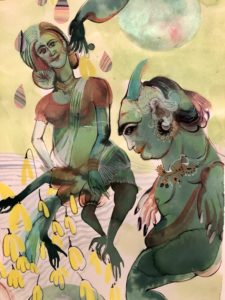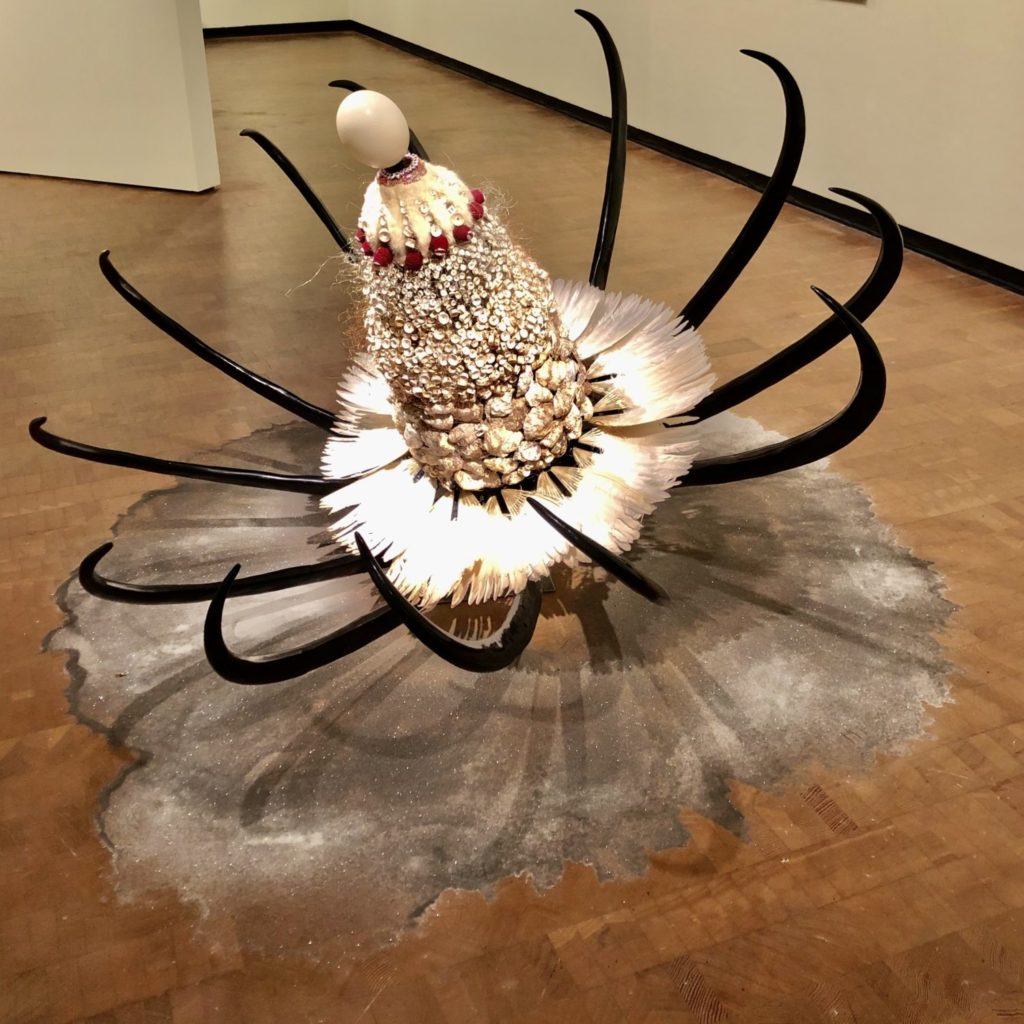At the Fowler a celebrated artist’s first major survey holds the whole world in its hands
The Fowler Museum’s unique focus on arts of international, non-Western, post-colonial and diasporic cultures makes it unique in Los Angeles, and the perfect host for Rina Banerjee’s emotionally and materially complex mid-career retrospective, Make Me a Summary of the World. That’s because Banerjee’s sculptural assemblages and large-scale installations are not only rich with a spectrum of eclectic elements the artist has acquired in her international travels — from toys and trinkets to historical cultural symbols and antiques, delicate textiles to medical and industrial objects, organic and natural components to synthetics and replicas. Beyond their captivating presence, the works are also profoundly engaged with issues of hybrid identity and the fractured cultural experiences of the modern post-imperial era.
Despite the foundational theories of inquiry into cultural portability and appropriation, and the artist’s not so subtle interrogations of how feminism and environmentalism function within that already complex sphere, the work claims an indelible embodied aesthetic. The magical, mysterious, seductive and sometimes unsettling works that result from her thoughtful practice are each masterpieces of assemblage with kaleidoscopic, delightful, ritualistic and spirited beauty. In any one of the several sculptures and vignettes installed at the Fowler, one can pick out African masks and jewelry, majestic feathers, light bulbs, surgical tubing, Chinese fans, Murano glass, Japanese and Korean fabrics, cowrie shells, baby dolls, Asian antiques, toy soldiers, beads, silk flowers, shimmering sand, metal work, dried Indian spices, sea creatures, land animals, grape vines, bone, fur, coral, lace, and a great deal more.

Rina Banerjee, Her captivity was once someone’s treasure and even pleasure but she blew and flew away took root which grew, we knew this was like no other feather, a third kind of bird that perched on vine intertwined was neither native nor her queens daughters, a peculiar other., 2011. (detail)
These eclectic materials she does not “find” or “reclaim” but, rather, diligently locates and purchases from their makers as both a chronicle of her own international travels and a gesture of support for the small and micro businesses who survive by selling them. She gathers this strange and wondrous bounty together, bursting with varieties of shape, texture and backstory, into singular objects that evoke familiar shapes — animals, humanoids, botanicals, totems, skeletons, architecture —while at the same time taking them apart. This is a powerful visual and conceptual analogy for what happens to a culture, religion, person, or language that is dispersed and recreated in a diaspora, speaking to the ways in which migrations uproot and relocate not only people, but their memories.
Banerjee was born in India, and as a child immigrated first to London and then to the United States, where she still lives and works. She studied chemical science before changing course and embracing the arts. As Marla C. Berns, the Fowler’s director, has said, “Banerjee’s art resonates with the Fowler’s mission, rejecting the idea that identity is based on one culture or gender. Instead, she embraces a multiplicity of experiences and a constant dance of negotiation and adaptation.”

Rina Banerjee at the Fowler Museum (Photo by Shana Nys Dambrot)
Aside from their intense physicality, one way in which Banerjee makes this theme of dissonance, translation and context more explicit specifically relates to the hegemony of English language in global institutions, as a vestige of colonial domination in its own right. Thus she gives her works lengthy titles of poetic, impenetrable syntax which render English as though “foreign” even to its most fluent speakers. For example, the title of a 2006 wall sculpture of white feathers, shells, and steel is “In dream with grin she kissed and licked his alligator wings, peeled his toes of all its nails and waled at the sight of killing.” Some of her literary titles are as long as 200 words and while they may not quite explicate the works in question, they certainly contribute to the experience of them.
The show’s eponymous central work “Make Me a Summary of the World! She was his guide and had traveled on camel, rhino, elephant and kangaroo, dedicated to dried plants, glass houses — for medical study, vegetable sexuality, self-pollination, fertilization her reach pierced the woods country by country,” from 2014 greets the viewer with a curvaceous, parasol-capped feminine totem-like presence. Its body comprised of fighters and animal forms, with the armature of gnarled grape vines, is a metaphor for both beauty and decay, the physical, fixed expression of a lifetime of memories all at once.
“Winter’s Flower—Raw materials from sea and from foul and even from some exotic mice was eaten by a world hungry for commerce made these into flower, disguised could be savored alongside whitened rice,” from 2009 is a monstrous, carnivore of a plant, dark fanged and elegant, alien and regal. Another work fills a Victorian bird cage with the trappings of lost childhood innocence, festooned with feathers, flowers, gourds, and other sacred-seeming objects. Its effect is both ark-like and tragic, charming and haunting, and — like all Banerjee’s most powerful work — both universal and mysterious.
Make Me a Summary of the World is on view at the Fowler Museum at UCLA through May 31. fowler.ucla.edu.

Rina Banerjee, Winter’s Flower…, 2009, installation view at the Fowler Museum (Photo by Shana Nys Dambrot)
Advertising disclosure: We may receive compensation for some of the links in our stories. Thank you for supporting LA Weekly and our advertisers.

